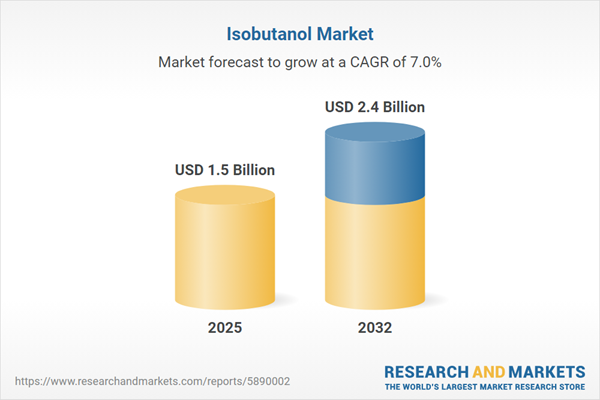Speak directly to the analyst to clarify any post sales queries you may have.
The isobutanol market is transforming to meet senior leaders’ priorities by delivering enhanced procurement agility, robust supply chain resilience, and sustainable sourcing capabilities within the complex global chemical sector.
Market Snapshot: Isobutanol Market Size, Growth, and Outlook
The global isobutanol market is projected to grow from USD 1.40 billion in 2024 to USD 1.50 billion in 2025 and to USD 2.40 billion by 2032, reflecting a 6.95% compound annual growth rate. This upward trajectory is driven by the increasing adoption of bio-based chemicals and intensifying focus on sustainability among procurement teams. Senior decision-makers are leveraging a balanced approach across both traditional petrochemical manufacturing and advanced fermentation technologies, strengthening their sourcing flexibility and ensuring compliance in an evolving regulatory environment. Versatile end-market applications—including construction, automotive, pharma, and consumer industries—along with ongoing technology innovation and evolving global trade dynamics, are shaping new strategies for isobutanol procurement and supply continuity.
Isobutanol Market Scope & Segmentation
- Applications: Utilized in pressure-sensitive adhesives, protective coatings, isobutyl acetate and isobutyraldehyde synthesis, fuel octane enhancement, excipient formulations, extraction solvents, flavoring agents, and industrial cleaning—positioning isobutanol across multiple interconnected value chains for evolving market requirements.
- End-Use Industries: Spanning hot melt adhesive manufacturing, gasoline blending, polymer production, cosmetic solvent development, fragrance and flavor formulations, and pharmaceutical intermediates. This broadens market reach, supporting both established and specialized global sectors.
- Production Processes: Includes hydroformylation, oxidation, and renewable-resource fermentation. Alignment with sustainability goals and compliance needs is facilitated through these varied manufacturing approaches that help organizations address environmental benchmarks.
- Purity Levels: Offered in EP, USP, analytical, laboratory, column-purified, distillation, agricultural, and industrial grades for meticulous compliance and technical application standards across end-markets.
- Feedstock Origins: Sources include agricultural residues, wood, isobutene, n-butene, potatoes, tapioca, corn, and sugarcane, enabling procurement teams to pivot amid fluctuating input costs and reinforce supply resilience.
- Distribution Channels: Market access through bulk agreements, OEM contracts, supply networks, direct supplier relationships, and digital platforms. Flexibility in channel selection helps organizations align procurement with operational goals.
- Regions Covered: Comprehensive global scope, with coverage across North America, Latin America, Europe, Middle East, Africa, and Asia-Pacific. Each region presents unique characteristics in market maturity and bio-based adoption, guiding region-specific sourcing and supply chain strategies.
- Leading Companies Profiled: Major suppliers include BASF SE, Dow Inc., LyondellBasell Industries, ExxonMobil Chemical Company, Eastman Chemical Company, Butamax Advanced Biofuels, Gevo, LG Chem, and Cargill—providing diverse procurement partners and capabilities for decision-makers.
Key Takeaways: Strategic Insights for Senior Leaders
- Increasing use of fermentation-based bio-isobutanol aligns procurement strategies with sustainability mandates and helps address emerging supply chain regulations and rising stakeholder scrutiny.
- Availability of distinct purity levels enables organizations to differentiate products within high-value segments such as coatings and pharmaceuticals while enhancing procurement compliance.
- Adopting multi-source procurement and flexible distribution methods enables organizations to maintain supply continuity in response to market or logistics disruptions, supporting operational resilience.
- Proactive investment in renewable feedstocks and novel process technologies contributes to company-wide ESG initiatives and reduces overall environmental footprint.
- Integration of digital procurement platforms with advanced manufacturing supports cost optimization and streamlines operational workflows amid rapidly shifting commodity markets.
- Strategic supplier agreements and collaborative partnerships expand market presence and increase reliability of supply in both mature and emerging regions.
Tariff Impact: Navigating US Trade Changes and Ensuring Supply Chain Agility
Recent changes to US tariff frameworks are prompting procurement leaders to reconsider their cost structures and prioritize domestic sourcing options for isobutanol. Developing regional supplier networks, investing in North American fermentation capabilities, and renegotiating supplier agreements are critical measures to safeguard business agility and continuity in the evolving US trade landscape.
Methodology & Data Sources: Comprehensive and Reliable Insights
This report compiles insights from top industry reports, official regulatory data, and direct interviews with engineers and procurement experts. Each finding is peer reviewed, ensuring that supply chain leaders in the isobutanol market can rely on actionable and validated intelligence.
Why This Report Matters: Actionable Intelligence for Senior Decision-Makers
- Delivers targeted recommendations to optimize procurement operations aligned with evolving technology and dynamic sourcing trends for isobutanol market participants.
- Highlights major risk and compliance issues, supporting both strategic regulatory planning and operational risk mitigation for procurement leaders.
- Enables businesses to elevate procurement transformation and adaptability, supporting organizational resilience in rapidly changing supply chain environments.
Conclusion
Access to robust market intelligence empowers senior decision-makers to confidently navigate complex procurement challenges, protect supply chain stability, and adapt to continued evolution in the isobutanol sector.
Additional Product Information:
- Purchase of this report includes 1 year online access with quarterly updates.
- This report can be updated on request. Please contact our Customer Experience team using the Ask a Question widget on our website.
Table of Contents
3. Executive Summary
4. Market Overview
7. Cumulative Impact of Artificial Intelligence 2025
Companies Mentioned
The companies profiled in this Isobutanol market report include:- BASF SE
- Dow Inc.
- LyondellBasell Industries N.V.
- ExxonMobil Chemical Company
- Eastman Chemical Company
- Butamax Advanced Biofuels LLC
- Gevo, Inc.
- LG Chem Ltd.
- Cargill, Incorporated
Table Information
| Report Attribute | Details |
|---|---|
| No. of Pages | 185 |
| Published | November 2025 |
| Forecast Period | 2025 - 2032 |
| Estimated Market Value ( USD | $ 1.5 Billion |
| Forecasted Market Value ( USD | $ 2.4 Billion |
| Compound Annual Growth Rate | 6.9% |
| Regions Covered | Global |
| No. of Companies Mentioned | 10 |









